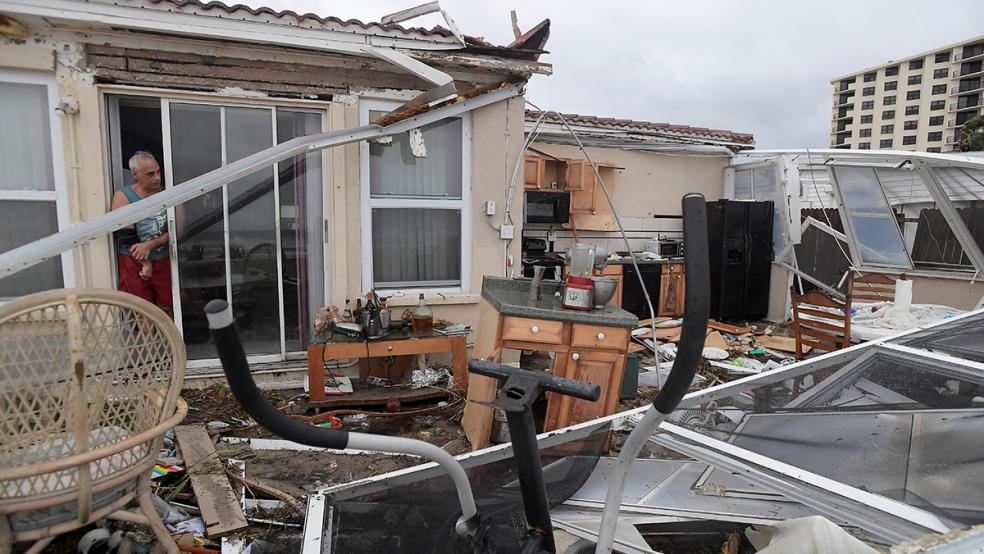It's looking like a busy season for hurricanes — and homeowners.
Prime time for these big storms along the Atlantic coast kicks off on June 1 and runs until Nov. 30.
Related: 12 Tax Breaks Every Homeowner Needs to Know
Scientists at the National Oceanic and Atmospheric Administration are forecasting "an above normal" hurricane season with as many as 11 to 17 named storms this year. Of those, 5 to 9 could become hurricanes. Four of these may become major hurricanes with sustained winds of at least 111 mph.
If you want to ensure that your homeowners and flood insurance coverage are sufficient, now is the time to act — it's way too late when the National Weather Service is announcing an emergency.
"It takes about 30 days to obtain a policy," said Doug Lyons, a financial advisor at Douglas J. Lyons Financial Group in Red Bank, New Jersey.
Hurricane Sandy, which bashed the East Coast in October 2012, resulted in $18.8 billion in estimated insured losses, according to Verisk Analytics' Property Claim Services.
Check these items in your existing policy to get a sense of how well you're covered in the event of a storm.
Homeowners insurance limits
Your homeowners coverage isn't bulletproof if a tropical storm or hurricane strikes your home.
For instance, your policy may have a hurricane deductible, making you responsible for the equivalent of 1 percent to 5 percent of your home's insured value.
Whether this deductible is applied will be based on your policy's terms and your state's insurance laws. In 2012, governors in New York, New Jersey and Connecticut told insurers not to apply hurricane deductibles when Sandy hit those states.
Related: The Real Cost of Filing a Homeowner’s Insurance Claim
Hurricane deductibles are in effect in 19 states and the District of Columbia, according to the Insurance Information Institute.
They are Alabama, Connecticut, Delaware, Florida, Georgia, Hawaii, Louisiana, Maine, Maryland, Massachusetts, Mississippi, New Jersey, New York, North Carolina, Pennsylvania, Rhode Island, South Carolina, Texas and Virginia.
Aim to have at least the amount you'd need to meet your deductible either in cash or in a home equity line that you arrange ahead of time.
"Beef up your emergency fund and make sure that your home isn't as vulnerable to windstorm or rain damage," said Laura Adams, senior insurance analyst at InsuranceQuotes.com.
Flood insurance
Your homeowner's coverage likely won't cover any damage related to flooding, so you'll need to buy this coverage through either the National Flood Insurance Program or the private market.
A 2016 poll from the Insurance Information Institute showed that 12 percent of American homeowners had a flood insurance policy.
Keep in mind that this isn't a cure-all: Under the program, coverage on the structure of your home is limited to $250,000, and your contents are protected up to $100,000.
It's better than nothing, but considering that many waterfront properties on the East Coast can cost millions of dollars, think about getting excess flood insurance — and do it now before the storms begin blowing in.
Related: Own a Home? Here Are 10 Tax Breaks for You
Limitations will apply
Finally, understand that your flood coverage doesn't fill in all of the areas that your homeowner's coverage will miss.
Damage resulting from a sewage backup after a flood may not be covered by your flood insurance, according to Craig Casazza, senior research analyst at ValuePenguin Research, a personal finance site. The same goes for mildew and mold damage.
"You can purchase extra endorsements to cover the nooks and crannies that you can miss," he said. "But unfortunately there may be bad cases where you won't be fully covered."
Here's your checklist
If you're ready to review your policy, here's what you need to look for.
Know your deductible: Understand the amount you'll need to pay out of pocket before your coverage kicks in. See how your hurricane deductible compares to your standard deductible.
Review your policy's details: Examine your homeowner's policy and see if your insurer will reimburse you for a hotel stay or rental home if you're displaced from your dwelling. Check the limits: These can be a per diem or a flat dollar amount.
Top up your insurance shortfalls now: If you haven't bought flood coverage, and you live near water, you're taking a big risk. Consider excess flood coverage if your home's value exceeds the $250,000 maximum covered by the National Flood Insurance Program.
Don't forget personal items: Think about adding endorsements to your homeowner's coverage so that you can replace high-end valuables, including jewelry and art.
Consider improvements to protect your home: Check valves can protect your home from sewage and drainage backflow. Roof clamps and window shutters can limit your wind damage in the event of a storm, said Loretta Worters, vice president for communications at the Insurance Information Institute. "Once you've let the wind in through a broken window, the likelihood is that you'll lose the roof and home," she said. "It's best not to go through that personal devastation and loss."
This article originally appeared on CNBC: Read more from CNBC.
Democrats feel their influence rising as Trump and GOP-led Congress struggle
Mark Zuckerberg cries while telling story about high school student afraid of being deported
Bitcoin 'nerds' give way to Wall Street suits at digital currency conference



